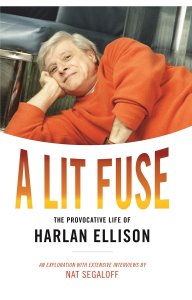Paul Di Filippo reviews Nat Segaloff
A Lit Fuse: The Provocative Life of Harlan Ellison, by Nat Segaloff (NESFA Press 978-1610373234, $35.00, 448pp, hardcover) July 2017
 Here is a sorta-kinda Harlan Ellison story you have never heard before, because it is known only to me, until now.
Here is a sorta-kinda Harlan Ellison story you have never heard before, because it is known only to me, until now.
In 1968 I was a freshman at Lincoln High School (Rhode Island) and one morning during home-room period–the free time before classes began–I, a dyed-in-the-wool dorky SF junkie-nerd-geek, was reading Ellison’s Earthman, Go Home! (otherwise Ellison Wonderland) in its Paperback Library incarnation that featured a truly lurid Jack Gaughan cover. When it came time to stand and recite the Pledge of Allegiance I set the book down, face-up, on my desktop. It caught the eye of the girl at the next desk and she began to snicker at the gauche illustration. Her amusement rapidly spread in circles around me and the louche offending book, until titters and giggles had totally disrupted the Pledge. It was a highly embarrassing moment and it had one lasting effect.
It caused me to love Harlan Ellison and his work unreservedly forever, not merely for the intrinsic qualities of the man and his art, but as one of the many emblems of the solidarity of dreamers and visionaries against the gawping ignorant world of unimaginative mundanes.
Decades later, thanks to various twists of fate, I have the luck and honor to number myself among Harlan’s friends, even if only on the outer periphery of that large gang. And so the arrival of Nat Segaloff’s long-awaited biography of the man is a momentous occasion for me. This is a book that should serve to cement Ellison’s achievements and reputation. But, moreover, it is an affirmation of the power of an individual’s will and talent to remake the world, even in the face of doubt, disdain and derision. And lastly, it is a vivid portrait of a whole vanished era of SF, as focused through the lens of Ellison’s wide-ranging career.
Despite plainly loving and admiring his subject, Segaloff has not produced a hagiography, but rather an objective, warts-and-all portrait. One might initially question the need for such a tome, given Ellison’s copious autobiographical output. But this book does the important job of assembling all–or many–of the scattered pieces, the many anecdotes and legends, into a coherent, linear, well-documented narrative that traces the long arc of Ellison’s life and career in accessible fashion. (Frequent footnotes, lots of photos, and a good index help.) Moreover, by incorporating large chunks of Ellison’s own speech (from many exclusive conversations) and his own published words–which jibe well with Segaloff’s own colloquial, irreverent, highly non-academic prose–the book mimics the freewheeling nature of its subject in a very agreeable manner.
After a heartfelt introduction by David Gerrold, the first chapter acquaints us with Ellison’s parents, his sister and his early Cleveland milieu. It establishes Ellison’s youthful character, his loves, hates and quirks, and ends with the untimely death of his father.
Chapter two takes our hero through high school, through SF fandom, and into the professional world of editing Rogue magazine, among other accomplishments. Segaloff shows that he, as biographer, is willing to skip around in time thematically when the narrative demands. Thus, hearing of Ellison’s first marriage, we also get an immediate foretaste of those to come. And in fact, as we shall soon see, Segaloff will abandon strict chronology at a certain point, in favor of totally thematic chapters, out of which the linear factual events of Ellison’s later life can be readily assembled.
Chapter three finds Ellison in those famous early years of prodom, pumping out stories to any venue that would have them. He gets the legendary affirmation from a Dorothy Parker review and relocates to California, commencing his large body of screenplay work. An atemporal sidebar into all Ellison’s marriages fills the pages of Chapter four.
It is at this point that the book completely dumps a strict month-by-month assemblage of the events of Ellison’s life in favor of topic-by-topic accounts. Thus, Chapter five details Ellison’s famous distaste for the label of “science fiction writer,” while the next chapter delves into his media review work–The Glass Teat, and other volumes. Chapter seven recounts the nature of Ellison’s tenacious friendships, while the next three chapters uncover the various failed and contentious projects–Starlost, I, Robot, “The City on the Edge of Forever,” et al. Chapter eleven brings a depiction of Ellison’s career as lecturer, and as sociopolitical commentator and gadfly. Ellison’s private passions for collecting books and other items fill Chapter twelve. Another three chapters offer an assessment of various controversies–the Connie Willis debacle, The Last Dangerous Visions–as well as gathering testimonials from friends and other-than-friends relating to the ultimate scope of Ellison’s personal life and his literary career. Chapter fifteen, the final one save for an Epilogue, brings us up to date on Ellison’s health crises, current writing projects (minimal, due to that failing mortal body), and self-assessments in the face of endgame conditions.
As stated earlier, Segaloff delivers plenty of sheer data, some of which is rarely heard, other bits of which are pretty familiar. I, for one, never knew of the lawsuit over a Tuckerism issued by an offended Judy Merril. He clarifies the origins of the famous “Harlan pushed a fan down an elevator shaft” anecdote. But other facts and factoids are missing. A couple of examples. I did not see an account, for instance, of Ellison’s heroic and controversial behavior at the 1969 Worldcon. And in the section declaiming Ellison’s support of new writers, there was no mention of the fairly significant “Harlan Ellison Discovery Series” of books. But really, given the depth and breadth of Ellison’s accomplishments, some filtering and exclusionary decisions had to be made, or the book would have been twice its size.
Ultimately, what Segaloff renders, with its inescapable imperfections and omissions, is a touching, honest, authentic and living simulacrum of the man, as granular and multiplex as possible in any such reverse-engineered eidolon. Here is a small summation of the man in question from towards the end of the book.
He is someone who wants to be noticed and also left alone. Someone who at times feels victimized and at other times becomes the gleeful perpetrator. A man who values friendship but also enjoys having enemies. He wants respect but denigrates it if it comes too easily, and he is proud of what he has achieved even as he dismisses it as just something he does. He is a man who has nothing to prove yet has been proving it all his life. He constructed a public persona to insulate himself is now trapped within it except for the few friends he allows to see inside. Predictably, each of them sees and loves something different.
There might yet come a more fastidious, finicky and fustily academic depiction of “Harlan Ellison, His Whole Goddamn Outrageous and Unabashed Life and Literary Loves.” But there will certainly never be another such groundbreaking and generously all-encompassing effort as the one that Segaloff has heartily assembled.
Finally, all thanks and reverence to NESFA Press for taking on this project, which surely would have gone begging if left to the untender mercies of the Big Five publishers.







Funny thing how I’m not mentioned in the book, despite a decades long love (at first, for more than 20 years) and hate (everything after the 80s) relationship. However, I was there starting in the 1960s, and you’ll find nearly a dozen of my photos in the book.